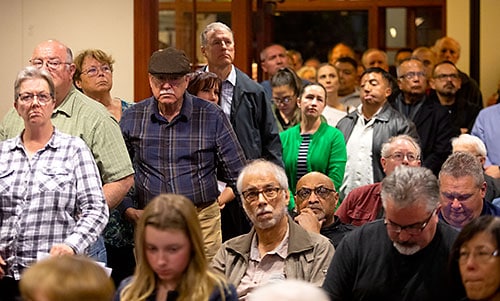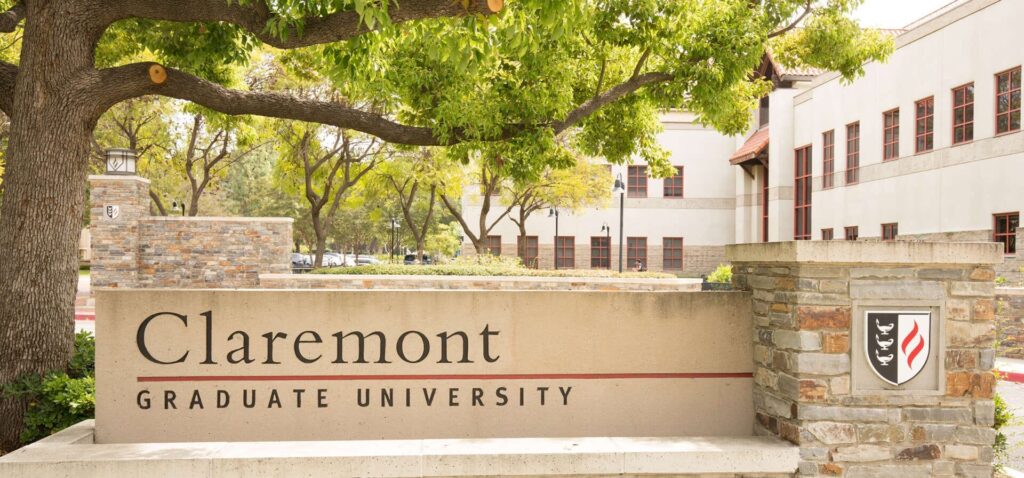Whew! 2020 is finally over. Here’s a Claremont year in review

by Steven Felschundneff | steven@claremont-courier.com
The biggest story of 2020 will come as no surprise, even to those individuals who remain skeptical of its very existence: SARS-CoV-2—the coronavirus.
The pandemic has upended life in such a profound manner that literally everything has changed. Some people have scarcely left their homes for nine months. Businesses closed, including Claremont mainstays such as the Moultrie Academy and the Claremont Club. The Colleges canceled commencement. People lost jobs, and many are facing economic uncertainty and the very real possibility they could lose their housing once the eviction moratorium is lifted. Every time you enter a local business, or come close to other people, you have to don a mask.
But most significantly, people have died. As I write this, 18 Claremont residents are gone. They were, for the most part, residents of our skilled nursing facilities and retirement homes. They were our grandparents, friends, parents and siblings. Some may say that 
On the bright side, by the first of the year, the two newly approved vaccines will be in the second or even third stages of distribution, bringing some hope that, as Los Angeles County Supervisor Hilda Solis said, “these dark days” will one day be over.
Looking through the COURIER archive in preparation for writing this year-in-review account, it was striking how suddenly everything turned from life as normal to this confusing, but necessary, mess of restrictions that continues to this day.
One day I was photographing a Claremont High School volleyball game and the very next day, I ventured out in a downpour to photograph students packing up to leave in advance of the Claremont Colleges’ complete shutdown.
On February 21, a profile of Susan Lominska and her efforts to assist 195 Americans who were flown from Wuhan, China to quarantine at March Air Reserve Base was the first story about the coronavirus to appear in the pages of the COURIER. A month later, reporting on the pandemic was almost all consuming.
On Monday, March 9, a woman died at Pomona Valley Hospital Medical Center, the first person in Los Angeles County to succumb to COVID-19. Two days later, the city of Claremont canceled all classes for senior citizens and events for everyone through mid April. On March 12, the Colleges closed, followed the next day by the closure of Claremont public schools.
Seemingly overnight, life in Claremont was thrown into disarray. Rumors of a statewide shutdown prompted people into a panic, emptying store shelves of everything from toilet paper to frozen and canned goods.
And then the shutdown came. On March 19, Governor Gavin Newsom announced a statewide order to stay at home, affecting 40 million Californians. The order restricted all non-essential travel and activities outside the home. In conjunction with the restrictions, the county issued a “Safer at Home” order mandating that residents stay home, except for necessary outings to the grocery store, pharmacy or workplace if deemed essential.
From there, nearly everything was canceled—or delayed only to eventually be canceled. It started with Arbor Day and the Spring Egg Hunt, then Memorial Day observances, the Fourth of July celebration and Village Venture. Instead, we had “virtual” events and get-togethers via Zoom. There were some clever solutions to the ban on in-person gatherings, including the Claremont Chamber of Commerce’s scarecrow decoration contest.
On a personal note, the pandemic provided an abrupt career change when, after 30 years as a news photographer (and part time sports reporter), I became the COURIER’s city reporter. My first coronavirus story was “Claremonters shift to life with social distancing,” which described the surreal scene at Trader Joe’s “as would-be shoppers picked through the scant items left on an endless sea of empty shelves while Don Henley’s ‘The End of the Innocence’ played on the sound system.”
Since then, I have written about the coronavirus weekly and will continue to do so as long as this virus continues to plague our community. Just this week I reported that a full 28 percent of all cases since the pandemic began in Claremont were diagnosed in just the last two weeks. I wonder what that number will be two weeks hence. Today I also reported on the first “frontline healthcare heroes” at Pomona Valley Hospital Medical Center receiving the vaccination.
As the economy shut down in March, again in July and again in December, the toll on our businesses remains incalculable. So many are gone for good, or may not survive the next few months. The COURIER reported earlier this month about the coalition of local restaurants banding together by continuing to serve sit-down customers outdoors. Critics countered that everyone is experiencing tough economic times, and that it is unfair for the owners of these restaurants to put others at risk. It seems to be one of those quandaries for which there is no easy or “right” answer.
In July, The Claremont Club abruptly announced its closure after 47 years in Claremont. The news sparked outrage and sadness, with a group of about 200 supporters holding a vigil in the parking lot vowing to save the Club. Since then there have been many rumors about a buyer who will continue to operate the institution as a fitness club, however, none of that talk has been substantiated.
If not for the virus, this year’s other big story would be the local reaction to the murder of George Floyd by Minneapolis police on May 25th. Protests swept the nation, including here in Claremont, with young people chanting “Black Lives Matter,” and calling for an end to systemic racism and police brutality.
In response to Mr. Floyd’s killing, Claremont natives Josue Barnes and Noah Winnick started the group Claremont Change with the goal of effecting transformation of the city’s police policy. The efforts of the two men have had a profound impact in just six months, with the Police Commission launching both a use of force ad hoc committee and one for community engagement and outreach. The police have introduced a new online form for public complaints, will most likely redesign the patch on police officers’ uniforms and are exploring whether the school resource officer is appropriate for Claremont.
In February the Claremont City Council officially said no to the Los Angeles County Sheriff’s Department taking over policing duties in our town. After dozens of citizens expressed their opinions in front of a standing room only crowd, the council voted unanimously to cease further exploration of contracting with the sheriff’s department.
And, of course, there was the election. Beginning with California moving its primary to Super Tuesday on March 3, the campaign season was long and contentious, with Democrats accusing Republicans of voter suppression and the GOP claiming voter fraud even before polling began. Los Angeles County came out big for President-Elect Joe Biden who earned 71 percent of the vote to Donald Trump’s 27 percent. Locally, we had our first ever Claremont City Council race since the city was divided into districts with Corey Calaycay winning re-election, now representing District 1, and Sal Medina getting the nod for District 5.
City Manager Tara Schultz abruptly left her job in October and received a severance package totaling nearly $214,000 in pay and benefits from the city of Claremont. The question that has yet to be answered, and perhaps will never be known, is why Ms. Schultz left, particularly mere days before an important election and in the middle of a pandemic. City officials would only say that it was a personnel matter, and would not comment further.
Future development and affordable housing was a multi pronged story that will be with us for years to come. The city’s commissions rejected The Commons, a planned mixed use project on Foothill Boulevard, which is under appeal. In contrast, the Colby Circle development got the go ahead despite neighborhood opposition.
Perhaps the most impactful housing and development story involves the semi industrial tract of land south and west of Claremont’s ever popular village. Three years in the making, the Village South Specific Plan was finalized late in the year with the environmental impact report not far behind. This particular plan—although it is years, if not decades away—will be key to Claremont’s ability to meet its obligations under the housing element requirement of the Regional Housing Needs Assessment.
In December, longtime Claremont City Council member Larry Schroeder retired and Jennifer Stark became mayor.
Tri-City Mental Health and the Claremont Police Department are set to unveil the Psychiatric Assessment Care Team in January, through which trained mental health professionals will respond to certain police calls.
Claremont resident Terri Wolfe Ingalls was killed while riding her bicycle north on Mills Avenue near Rockford Drive in late November. Ms. Ingalls was part of the family who has owned Wolfe’s Market for decades.
In November, Acting City Manager Adam Pirrie announced that expected city revenue shortfalls due to the COVID-19 pandemic were not as steep as previously anticipated.
This summer, local blazes such as the Bobcat Fire, closed the Wilderness Park and resulted in terrible air quality for weeks. Thankfully, there were no fires here, while the destruction to other neighboring cities was devastating.
Claremont’s Director of Human Services Anne Turner resigned from her position on September 15.
For the first time in more than eight years, Claremont committed to construct new affordable housing when the city council voted unanimously in July to approve city funding for a 15-unit project located at 956 W. Base Line Rd.
In May, the city of Claremont’s small business grant program received so many inquiries on the first day of eligibility that officials stopped accepting requests an hour and 40 minutes after the application process began.
In early April, the Claremont Colleges closed their campuses to the public as part of a coordinated effort to comply with the governor’s Stay-at-Home order. The move was very unpopular with many Claremont residents who enjoy walking through the institutions’ bucolic grounds.











0 Comments